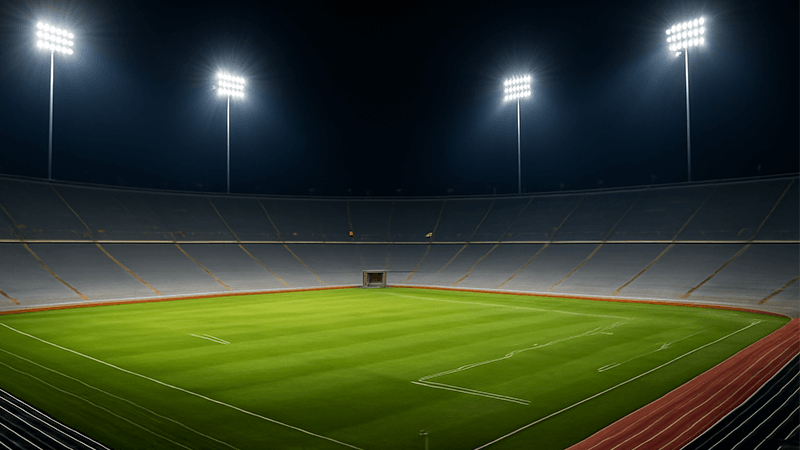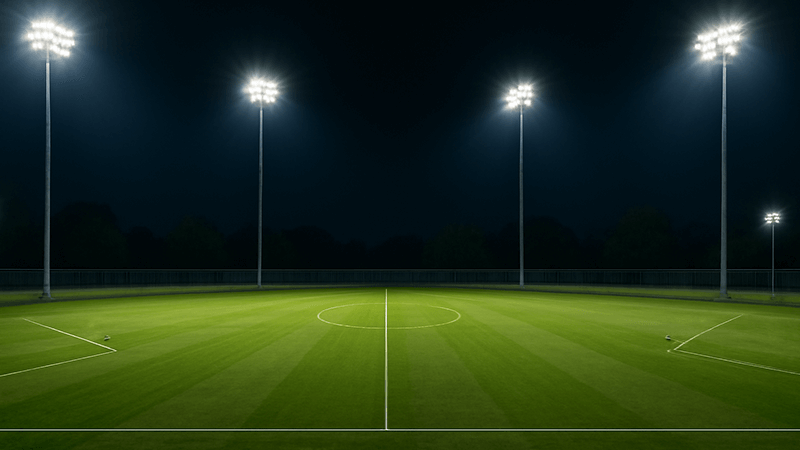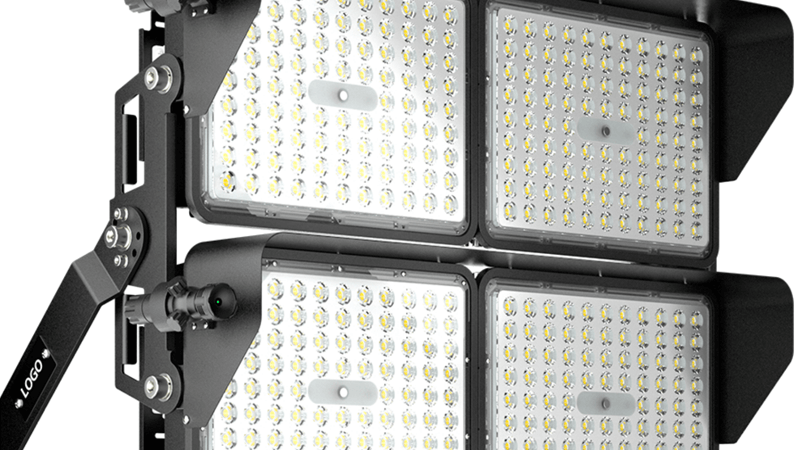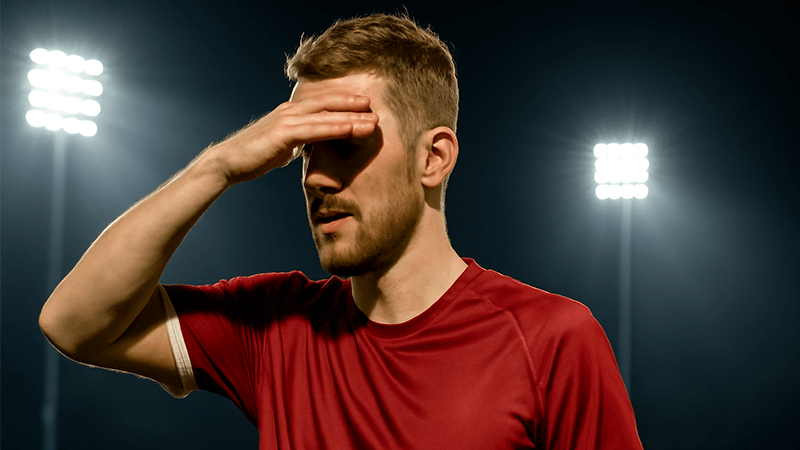Battling with inconsistent lighting that dims the excitement of the game? Poor lighting impacts players and fans alike, creating a frustrating and unprofessional atmosphere for everyone involved.
LED floodlights are essential for modern sports stadiums. They provide powerful, uniform, and controllable illumination. This ensures excellent visibility for players, spectators, and broadcast cameras, meeting the strict standards required for professional sports.

When I first started in the LED lighting industry, I saw many projects focus only on a few simple metrics. They would measure the light hitting the ground and call it a day. But I quickly learned, especially from clients like Shaz in the UAE who manage large-scale projects, that world-class stadium lighting is so much more complex. It’s an art and a science. It’s about creating an experience. Let’s explore what really goes into making a stadium shine, moving beyond just basic brightness to what truly makes a difference for the game.
Which type of lighting scheme is used in stadiums?
Ever been to a game where you lose sight of the ball against the dark sky? This happens when the lighting scheme is poorly planned, focusing only on the ground and creating poor contrast.
Stadiums typically use a high-mast lighting scheme. This involves placing clusters of powerful floodlights on tall poles or on the roof structure. The goal is to create overlapping light patterns that provide consistent and uniform illumination across the entire playing area.

Going deeper, the specific arrangement of these high-mast lights is critical. There isn’t just one way to do it. The choice depends on the stadium’s architecture, the specific sport being played, and broadcast requirements. For many years, the standard was a four-corner or six-to-eight pole layout. This system is effective for lighting the horizontal playing surface—the ground itself. However, a major issue I’ve seen with this traditional approach is its failure to provide adequate vertical illuminance.
Vertical illuminance is the light that falls on vertical surfaces, like a player’s body or a ball in mid-air. When we only focus on horizontal brightness, we get a flat image. For sports like football or tennis, the ball spends a lot of time in the air. Without strong vertical light, cameras can’t capture the ball clearly, and players might struggle to track it against the night sky. The athletes themselves can appear as flat figures without depth. To solve this, modern designs often use a "ring of light" or continuous light strip system along the roofline. This provides more angles of light, significantly improving vertical illuminance and creating a much better experience for both live spectators and a global television audience.
| Lighting Scheme |
Primary Focus |
Best Use Case |
Vertical Illuminance |
| Corner Masts (4-6 Poles) |
Horizontal Illuminance |
Community fields, older stadiums |
Often Poor to Fair |
| Side-Line Masts (Multiple Poles) |
Good Horizontal Uniformity |
Rectangular fields (Soccer, Football) |
Fair to Good |
| Ring Lighting (Roofline) |
Vertical & Horizontal Illuminance |
Modern, multi-purpose stadiums |
Excellent |
For a purchasing manager like Shaz, understanding this distinction is key. He doesn’t just buy "lights"; he sources a complete visual system. We often discuss how a design prioritizing vertical illuminance prevents broadcast issues and ensures a top-tier sporting event.
What are the regulations for stadium lights?
Are you worried your stadium project won’t meet international standards? Failing to comply with lighting regulations can get your facility disqualified from hosting major events, wasting a huge investment.
Sports lighting regulations, set by bodies like FIFA, the IES, and the Olympics, specify minimum levels for illuminance (brightness), uniformity, glare control, and color rendering. These standards ensure player safety, fair play, and high-quality broadcasting for different levels of competition.

These regulations are not just suggestions; they are comprehensive guides that define the quality of play. Let’s break down the key parameters. Illuminance is measured in lux. For a non-televised local game, 200 lux might be enough. But for an international HDTV broadcast, you need over 2000 lux on the field. Even more important than the raw brightness is uniformity. This is expressed as a ratio, measuring the minimum lux level against the average. A high uniformity ratio (like 0.7 or higher) means no distracting bright spots or dark patches on the field.
This is where my insight on vertical illuminance becomes so important again. Major sports federations now have specific regulations for vertical illuminance. They understand that a camera needs to see the players’ faces, the numbers on their jerseys, and the ball in flight. If the vertical lighting is poor, the broadcast quality suffers, no matter how bright the ground is. The image will lack depth and clarity. For example, capturing the spin on a fast-moving cricket ball for a slow-motion replay is impossible without excellent, multi-directional vertical lighting. I always advise my partners to look beyond the basic horizontal lux numbers. We need to plan for camera positions and ensure the light distribution creates a vivid, three-dimensional scene that meets the strictest broadcast standards. This proactive approach avoids costly mistakes and ensures the venue is ready for any level of competition.
Why are stadium lights called flood lights?
People often wonder why the huge lights at stadiums have a specific name. Isn’t a light just a light? Using the wrong term can lead to confusion when sourcing products for a project.
Stadium lights are called floodlights because they are designed to "flood" a very large area with a wide, powerful beam of light. Unlike spotlights that focus on a single point, floodlights provide broad, general illumination to cover the entire playing surface uniformly.

The name perfectly describes its function. Think of it like water. A spotlight is like a jet stream, hitting a small, specific target. A floodlight is like opening a dam, letting light wash over a vast space. This design is fundamental to sports lighting. You don’t want to light up just the penalty box in soccer or just the pitcher’s mound in baseball. You need seamless, consistent light from one end of the field to the other.
The technology inside a floodlight makes this possible. It uses advanced optics—lenses and reflectors—to take the powerful light generated by the LED source and shape it into a wide beam. In my manufacturing experience, customizing these optics is one of the most important parts of the design process. We can create floodlights with very wide beam angles for fixtures placed close to the field, or narrower beams for lights mounted high up on masts. The goal is to layer these beams from multiple floodlights to smooth out any potential shadows and achieve the high uniformity I mentioned earlier. This is also why we don’t use just one giant light. By using dozens or even hundreds of individual floodlights, we can aim each one precisely. This meticulous process ensures every square meter of the field, both horizontal and vertical, gets the right amount of light, creating the perfect stage for the sport.
What is the glare rating for sports lighting?
Have you ever tried to catch a ball while looking directly into a blinding light? Glare is not just annoying; it’s dangerous for players and ruins the viewing experience for fans.
The glare rating (GR) is a value on a scale from 10 (unnoticeable) to 90 (unbearable) that measures the level of visual discomfort caused by bright lights. For sports lighting, international standards require a GR of less than 50 (GR<50) to ensure safety and performance.

Controlling glare is one of the toughest challenges in stadium lighting design. It’s a delicate balance. You need incredibly bright lights to meet illuminance standards, but you have to position and aim them so they don’t shine directly into people’s eyes. Excessive glare can cause players to miss a crucial play or even lead to injury. For spectators and cameras, it can make watching the game impossible. This is why a simple brightness measurement is not enough. You must consider where the light is coming from.
This ties back directly to my point about vertical illuminance. To light vertical surfaces well, you need light coming from the side. But if the angle is too low, or the light fixture doesn’t have proper shielding, that light will go straight into a player’s line of sight, creating massive glare. This is a common mistake I see in poorly planned projects. They add more lights to boost vertical illuminance but end up creating a glary mess. The solution lies in superior product design and meticulous planning. Modern LED floodlights use specialized optics, baffles, and shields to precisely cut off the light beam, keeping it on the field and out of the players’ and spectators’ eyes. We use lighting simulation software to model the GR value from every important viewpoint in the stadium before a single light is ever installed. For my clients, ensuring a GR below 50 isn’t just about meeting a rule; it’s about delivering a professional-quality venue where athletes can perform at their best.
| Glare Rating (GR) |
Perception |
Suitability in Sports |
| GR < 40 |
Unnoticeable to Slight |
Ideal for Professional Broadcast |
| GR 40 – 50 |
Tolerable |
Acceptable for most sports |
| GR > 55 |
Uncomfortable |
Unacceptable for any sport |
Conclusion
Ultimately, successful stadium lighting depends on a holistic design using high-quality LED floodlights that balance brightness, uniformity, and glare control to create the perfect environment for everyone.